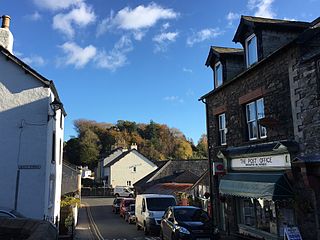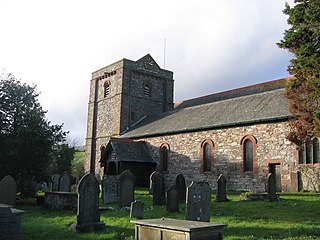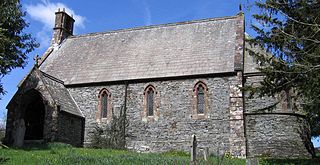
Broughton in Furness is a market town in the civil parish of Broughton West in the Westmorland and Furness district of Cumbria, England. It had a population of 529 at the 2011 Census. It is located on the south western boundary of England's Lake District National Park, and in the Furness region, which is within the historic boundaries of Lancashire.
George Webster was an English architect who practised in Kendal, which was at the time in Westmorland, and later in Cumbria. All of his works were executed near his practice, and were located in Cumbria, in north Lancashire, and in the adjacent parts of Yorkshire. Most of his work was carried out on domestic buildings, but he also designed churches, and public and commercial buildings.

St Martin's Church is in Front Street, Brampton, Cumbria, England. It is an active Anglican parish church in the deanery of Brampton, the archdeaconry of Carlisle and the diocese of Carlisle. It is recorded in the National Heritage List for England as a designated Grade I listed building and is the only church designed by the Pre-Raphaelite architect Philip Webb. The architectural historian Nikolaus Pevsner described it as "a very remarkable building".

St Mary Magdalene's Church is in Broughton-in-Furness, Cumbria, England. It is an active Anglican parish church in the deanery of Furness, the archdeaconry of Westmorland and Furness, and the diocese of Carlisle. Its benefice is united with those of four other local parishes. The church, dedicated to Jesus' companion Mary Magdalene, is recorded in the National Heritage List for England as a designated Grade II listed building.

Rochdale Town Hall is a Victorian-era municipal building in Rochdale, Greater Manchester, England. It is "widely recognised as being one of the finest municipal buildings in the country", and is recorded in the National Heritage List for England as a designated Grade I listed building.

St Michael and All Angels Church is in the village of Hawkshead, Cumbria, England. It is an active Anglican parish church in the deanery of Windermere, the archdeaconry of Westmorland and Furness, and the diocese of Carlisle. Its benefice is united with those of four local parishes to form the Benefice of Hawkshead with Low Wray and Sawrey and Rusland and Satterthwaite. The church is recorded in the National Heritage List for England as a designated Grade I listed building. Hyde and Pevsner, in the Buildings of England series, describe it as being "one of the best Lake District churches".

St Mary's Church is in the town of Kirkby Lonsdale, Cumbria, England. It is an active Anglican parish church in the deanery of Kendal, the archdeaconry of Westmorland and Furness, and the diocese of Carlisle. Its benefice is united with those of six local churches to form the Kirkby Lonsdale Team Ministry. The church contains Norman architecture and is recorded in the National Heritage List for England as a designated Grade I listed building.

Woodland is a dispersed hamlet within the civil parish of Kirkby Ireleth in the Furness region of Cumbria, England, and is located in the southern part of the Lake District National Park, west of Coniston Water, between Torver and Broughton-in-Furness.

Southport Arts Centre, formerly known as Cambridge Hall, is on the east side of Lord Street, Southport, Sefton, Merseyside, England, and stands between Southport Town Hall and the Atkinson Art Gallery and Library. It was built in 1873–74 and originally contained an assembly hall. The centre contains mixed architectural styles and has a tall clock tower at the right end. During the 20th century the assembly hall was converted into a theatre, and it forms part of the arts complex known as The Atkinson. The arts centre is recorded in the National Heritage List for England as a designated Grade II listed building.
Broughton West is a civil parish in the South Lakeland District of Cumbria, England. It contains 39 listed buildings that are recorded in the National Heritage List for England. Of these, two are listed at Grade II*, the middle of the three grades, and the others are at Grade II, the lowest grade. The parish contains the market town of Broughton-in-Furness and a number of small villages and settlements, including Broughton Mills, but is otherwise rural. Many of the listed buildings are located in Broughton-in-Furness, and the others are scattered around the parish. Most of the listed buildings are country houses, smaller houses and associated structures, and farmhouses and farm buildings. The other listed buildings include a church and items in the churchyard, bridges, public houses, a former market hall, a commemorative obelisk, stocks, a limekiln and market benches.

Corn exchanges are distinct buildings which were originally created as a venue for corn merchants to meet and arrange pricing with farmers for the sale of wheat, barley, and other corn crops. The word "corn" in British English denotes all cereal grains, such as wheat and barley. With the repeal of the Corn Laws in 1846, a large number of corn exchanges were built in England, particularly in the corn-growing areas of Eastern England.

The Old Town Hall is a municipal building in the Market Place, Carlisle, England. It is a Grade I listed building.

Berwick Town Hall is a municipal facility in Marygate, Berwick-upon-Tweed, England. The town hall, which was the headquarters of Berwick-upon-Tweed Borough Council, is a Grade I listed building.

Thame Town Hall is a municipal building in the High Street, Thame, Oxfordshire, England. The town hall, which is the meeting place of Thame Town Council, is a Grade II listed building.

Colne Town Hall is a municipal building in Albert Road, Colne, Lancashire, England. The town hall, which is the meeting place of Colne Town Council, is a grade II listed building.

Marlow Town Hall is a municipal building in the Market Square, Marlow, Buckinghamshire, England. The structure, which was used as a public events venue, is a Grade II* listed building.

Garstang Town Hall is a municipal building in the High Street in Garstang, Lancashire, England. The structure, which currently accommodates two shops and a Royal British Legion Club, is a Grade II listed building.

Leconfield Hall, formerly Petworth Town Hall, is a municipal building in the Market Square in Petworth, West Sussex, England. The building, which is now used as a cinema, is a Grade II* listed building.

Dalton Town Hall is a municipal building in Station Road, Dalton-in-Furness, a town in Cumbria, England. The building, which accommodates the offices and meeting place of Dalton-in-Furness Town Council, is a Grade II listed building.

The Old Town Hall, also known as the Market House, is a former municipal building in the Market Square, Millom, a town in Cumbria, England. The building currently accommodates a bar and restaurant known as the "Clock Tower".



















